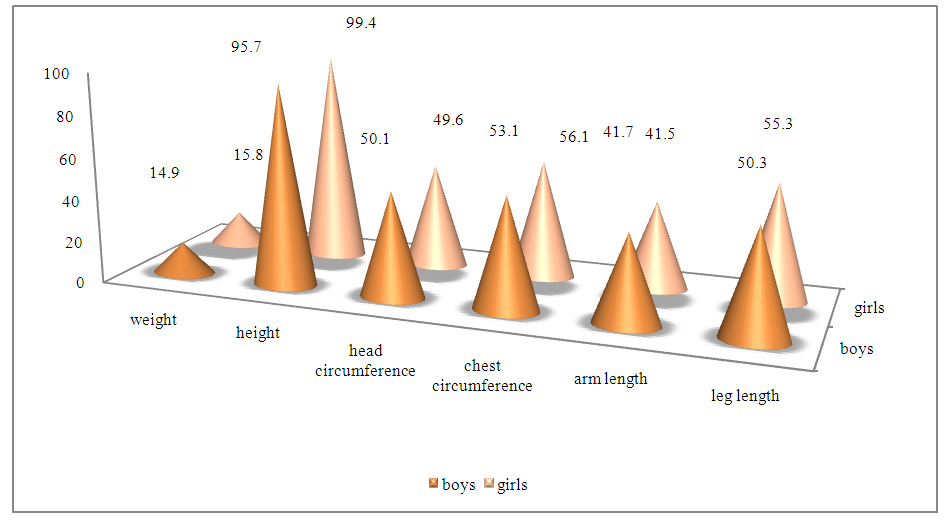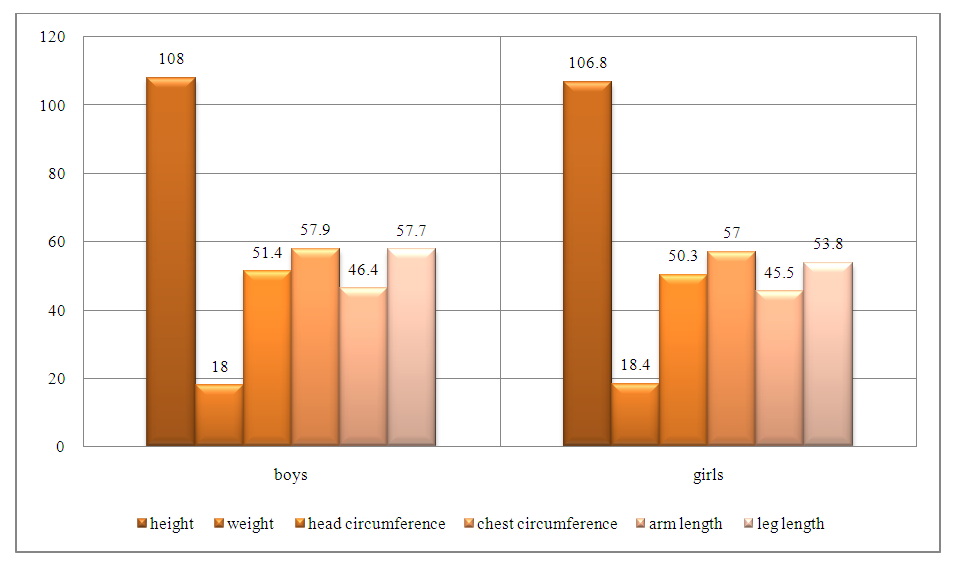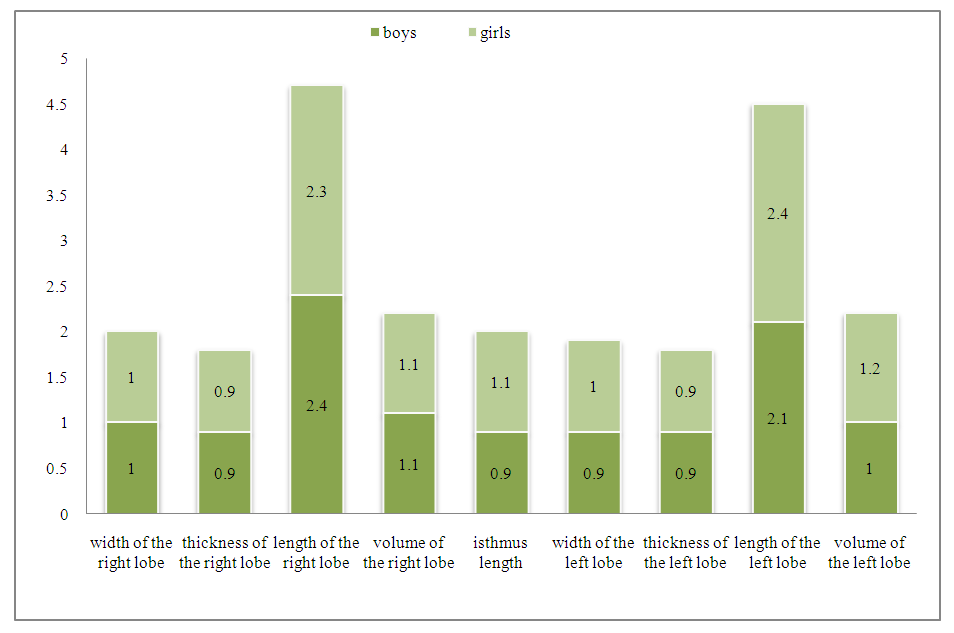Panоev Khurshid Shukhratovich, Teshaev Shukhrat Jumaevich, Navruzova Shakar Istamovna
Bukhara State Medical Institute, Uzbekistan
Copyright © 2024 The Author(s). Published by Scientific & Academic Publishing.
This work is licensed under the Creative Commons Attribution International License (CC BY).
http://creativecommons.org/licenses/by/4.0/

Abstract
Psychomotor development of children is an urgent problem for many states and its medical and social significance is currently increasing. Early diagnosis and prevention of delayed psychomotor development of children can reduce morbidity and disability. The article is devoted to the development of a scheme for predicting the psychomotor development of preschool children, which is of great importance for health authorities when organizing specialized pediatric and medical-pedagogical, preventive services. The proposed method allows early diagnosis and prevention of disorders of psychomotor development in preschool children, which is of important medical and social importance.
Keywords:
Children, Psychomotor development, Thyroid gland, Preschool age, Anthropometry
Cite this paper: Panоev Khurshid Shukhratovich, Teshaev Shukhrat Jumaevich, Navruzova Shakar Istamovna, Prediction of Psychomotor Development of Children in a Complex of Morphometric Indicators and Thyroid Dysfunction, American Journal of Medicine and Medical Sciences, Vol. 4 No. 2, 2024, pp. 243-247. doi: 10.5923/j.ajmms.20241402.16.
1. Introduction
The problem of the development of the psychomotor sphere of preschoolers is relevant today, since this sphere is one of the indicators of the harmonious development of personality, and its proper development ensures the social well-being of the child. The sensitive period of psychomotor development is preschool age. It is during this period that the intensive physical and mental development of the child takes place [1].The intensity of school education, due to the complexity of solving problems in the context of modernization of education, requires high mental stress and perfect psychomotor self-regulation [3]. The improvement of the system of lifelong education of the younger generation is impossible without a holistic understanding of the mental and motor activity of the student and an in-depth study of the psychophysiological determinants of psychomotor development at all stages of lifelong education. Any mental activity would have no meaning if it did not end with movement. Motor actions, being included in the perceptual activity of the child, also perform an epistemological function [4,6]. It is generally believed that psychomotor development is the process of changing and becoming functional systems of the body, which are based on arbitrary movements during its individual and social life. At an outpatient appointment in a children's polyclinic, pediatricians quite often face a variety of complaints from parents about the health status of their children. Fatigue, weakness, drowsiness, decreased memory, attention, decreased academic performance at school, delayed psychomotor development due to iodine deficiency in the body, and consult with an endocrinologist. Thyroid diseases occupy a leading place among the entire pathology of the endocrine system, and iodine deficiency conditions are among the most common non-communicable human diseases [2,5,7].The aim of the study is to develop a method for predicting the psychomotor development of children in a complex of integrated assessment of morphometric indicators and thyroid dysfunction in children.
2. Materials and Methods of Research
A survey of 1,390 organized preschool children living in the Bukhara region was conducted. Of these, 721 are girls, 669 are boys aged 3-7 years. The analysis, depending on the place of residence, showed that there are only 667 children living in rural conditions, 313 of them boys (46.9%), 354 girls (53.1%). There are 723 children living in the city, 356 of them boys (49.3%), 367 girls (50.7%). The ratio of urban and rural children was 1:1.
3. Results and Discussion
The results of the distribution of children by age and place of residence showed the predominance of organized children in preschool institutions (DDU) at the age of 4-6 years, regardless of the place of residence.The study of the physical growth of preschool children showed that girls of 4 years of age are ahead of boys in height, weight, chest circumference and leg length (Fig.1).  | Figure 1. Indicators of physical growth of children aged 4 years |
At the same time, boys' average physical development indicators were at the weight level of -14.9±0.24 kg compared to girls' weight of 15.8±0.24 kg (p<0.05). The height of boys aged 4 years was 95.7±0.70 cm compared to the height of girls-99.4±1.19 cm (p<0.05). During the analysis, a statistically significant large breast circumference was found in girls-56.1±0.31 cm versus indicators in boys - 53.1±0.31 cm (p<0.05). And also the length of the legs in girls was - 55.3 ± 0.49 cm versus the length of the legs in boys -50.3±0.23 cm, which shows the reliability of the results obtained by comparing the indicators of physical development of children aged 4 years (p <0.05).The results of the study showed that boys received a higher score on the psychomotor development assessment scale - 83.6 ± 1.91 points, compared with the data for girls of the corresponding age -81.5 ± 1.52 points. A more detailed study of morphometric parameters and thyroid hormones in 4-year-old children showed that in boys the length of the right and left lobes of the thyroid is greater than in girls, 2.7±0.09 cm and 2.4 ±0.05 cm, respectively, (p<0.05). At the same time, the volume of the left lobe of the thyroid gland in boys is 2.0 times greater than in girls: 1.2±0.13 cm and 0.6±0.04 cm (p<0.05), (Fig.2). | Figure 2. Indicators for assessing psychomotor development on a modified scale, taking into account morphometric and functional parameters of the thyroid gland in children aged 4 years |
Analysis of the state of thyroid hormone synthesis showed higher titers of free T4- 25.7±0.72 pmol/l and TSH- 2.4±0.21 pmol/L in boys versus data in girls, 19.1±0.91 pmol/l and 1.4±0.09 pmol/l, respectively (p<0.05).Evaluation of thyroid hormone synthesis allowed to establish an increase in the level of total T3 in girls to 2.7±0.14 mmol/l compared with its synthesis in boys - 2.0±0.15 pmol/l (p<0.05).Thus, the results of the study made it possible to establish the peculiarities of psychomotor and physical development in children aged 4 years, depending on gender. It was found that girls of 4 years of age are ahead of boys in height, weight, chest circumference and leg length. At the same time, the length of the right and left lobes of the thyroid gland is greater in boys than in girls, the volume of the left lobe of the thyroid gland is 2.0 times greater than in girls (p<0.05). They also revealed an increased synthesis of T4 and TSH in boys, and an increase in the level of total T3 in girls.Evaluation of thyroid hormone synthesis allowed to establish an increase in the level of total T3 in girls to 2.7±0.14 mmol/l compared with its synthesis in boys - 2.0±0.15 pmol/l (p<0.05).Consequently, in girls, an increase in the level of total T3 indicates a lack of iodine in the body and a high risk of endemic goiter.A comparative assessment of the physical growth of 5-year-old children allowed us to establish an increased growth of boys than girls. At the same time, boys are also ahead of girls in terms of chest circumference, arm and leg length (Fig.3). | Figure 3. Indicators of physical growth of 5-year-old children |
The results obtained show a pattern of growth and development of children. The assessment of psychomotor development at school showed the same set of points regardless of gender, boys scored an average of 81.3 = 2.09 points, girls - 81.2 = 2.28 points. The results obtained indicate an increase in psychomotor development in children aged 5 years, regardless of gender and physical development indicators.Morphometric characteristics of the thyroid gland showed that the length of the right lobe of the thyroid gland in boys is greater - 2.4± 0.04 cm than in girls- 2.3±0.07 cm (Fig.4). | Figure 4. Morphometric parameters of the thyroid gland in children aged 5 years |
At the same time, the width of the left lobe of the thyroid gland in girls is greater than 2.4 ± 0.05 cm than in boys-2.1± 0.03 cm.Analysis of the state of thyroid hormone synthesis allowed to establish activation of synthesis of total T3, free T4 and TSH in boys. The results obtained do not have statistical significance, but show the course of iodine deficiency in girls.To study the parameters of physical growth and development of children and the prognosis of their psychomotor development in dynamics depending on age, some mechanisms of impaired intellectual development of children are revealed. Taking into account the above data from the results of the study, in order to predict the degree of psychomotor development, we studied the physical development of 6-year-old children.As a result, boys were found to be taller than girls. And also, the chest circumference in boys is larger than in girls, on average 59.1± 0.6 cm compared to 57.25± 0.83 cm in girls (p<0.05).The assessment of psychomotor development on a scale showed that girls score more points at the age of 6 than boys. That is, the intellectual development of girls at the age of 6 is higher than boys, 87.3 ± 2.12 points and 90.0 ± 1.92 points, respectively.Morphometric parameters of thyroid gland in children aged 6 years differ slightly depending on gender. In boys, the volume of the right lobe of the thyroid gland (1.7± 0.18 cm), width (1.4± 0.08 cm) and volume of the left lobe (1.6 ± 0.09 cm) are larger than in girls: 1.4± 0.12 cm, 1.24± 0.03 cm and 1.5± 0.09 cm, respectively. Although the results obtained are not statistically significant, they show a tendency to increase the volume of the right and left lobes, due to an increase in the width of the left lobe of the thyroid gland in boys.Analysis of thyroid hormone levels in children aged 6 years showed a high titer of free T4 in boys-28.1 ± 1.66 pmol/l (p<0.05), which indicates activation of thyroid function possibly as a result of stress, mental stress and respiratory infections. Consequently, at this age, boys have a high risk of developing diffuse toxic goiter against the background of an increase in free T4 in the blood.At the same time, girls aged 6 years have a decrease in the level of free T4, which indicates an iodine deficiency condition with a high risk of secondary hypothyroidism.Thus, a comprehensive assessment of the physical and psychomotor development of children with morphometric indicators of thyroid gland and the state of synthesis of its hormones in children, depending on age, made it possible to determine their age-sexual characteristics and predict the risk of developing thyroid diseases.
4. Conclusions
1. The prevalence of organized children in preschool institutions (DCS) at the age of 4-6 years has been established, regardless of their place of residence 2. In children aged 4 years, the functional state of the thyroid gland does not depend on the indicators of physical development. A high risk of developing iodine deficiency in girls aged 5 years has been established, which is clinically manifested by the lag in growth of girls against the background of a tendency to gain weight, a lag in the growth of the circumference of the head and chest, the length of the arms and legs compared to the physical growth of boys. 3. A high risk of developing diffuse toxic goiter in boys aged 6 years was established against the background of an increase in free T4 in the blood Thyroxine (free T4) and the width of the left lobe of the thyroid gland are more informative indicators of the activity of psychomotor development of boys. Triiodothyronine (total T3) and the thickness of the isthmus of the thyroid gland in girls are indicators of delayed psychomotor development. At the same time, the more triiodothyronine in the blood, the smaller the thickness of the isthmus of the thyroid gland and the low score on the scale of assessment of psychomotor development of girls.
References
| [1] | Лукманова Наталья Борисовна, Волокитина Т. В., Гудков А. Б., Сафонова О. А. Динамика параметров психомоторного развития детей 7-9 лет // Экология человека. 2014. №8. URL: https://cyberleninka.ru/article/n/dinamika-parametrov-psihomotornogo-razvitiya-detey-7-9-let. |
| [2] | Намазова Л. С., Широкова Ирина Васильевна Профилактика йоддефицитных заболеваний // ПФ. 2018. №2. URL: https://cyberleninka.ru/article/n/profilaktika-yoddefitsitnyh-zabolevaniy. |
| [3] | Practical Paediatric Endocrinology in a Limited Resource Setting / Editor Zacharin M. - Melburne, Australia, 2019. - 320 p. |
| [4] | Raymond J. Fetal and neonatal thyroid function: review and summary of significant new findings / J. Raymond, S.H. La Franchi // Curr. Opin. Endocrinol. Diabetes Obes. - 2020. - № 17 (1). - Р. 1-7. |
| [5] | Raine Joseph E. Practical Endocrinology and Diabetes in Children / Raine Joseph E., Malcolm D.C. Donaldson, John W. Gregory, Guy Van Vilet. - 3rd edition. - Wiley-Blackwell. - 2020. - 258 p. |
| [6] | Zimmermann M.B. Iodine Deficiency // Endocrine Reviews. - 2019. - 30 (4). - P. 376-408. 13. |
| [7] | WHO, UNICEF, and ICCIDD. Assessment of the Iodine Deficiency Disorders and monitoring their elimination. Third edition. - Geneva: WHO, WHO/Euro/NUT. - 2017. - P. 1-98. |






 Abstract
Abstract Reference
Reference Full-Text PDF
Full-Text PDF Full-text HTML
Full-text HTML